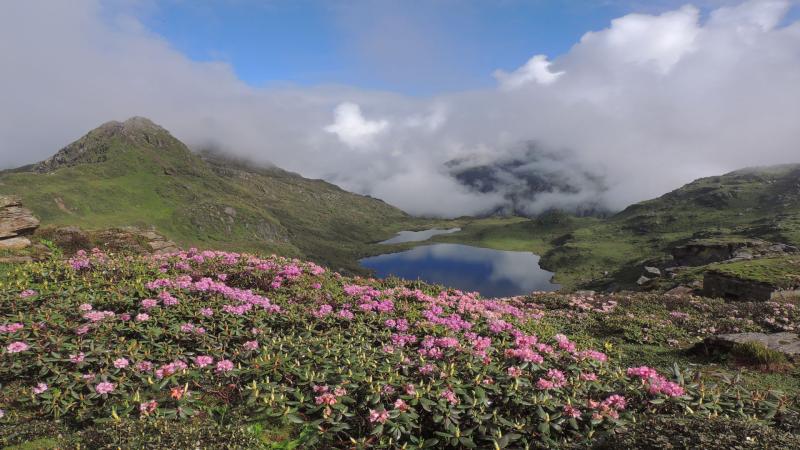
The flowers in the Himalaya, a favourite among mountaineers, may have borrowed a lesson or two from the adrenaline-high visitors. As they climb higher, mountaineers carry only essential things, shedding any extra baggage. Likewise, the flowers here shrink in their size and hold less nectar to suit their tiny pollinators, finds a recent study on Rhododendrons—a type of woody flowering plants.
The study was conducted by researchers at the Ashoka Trust for Research in Ecology and Environment, Bengaluru and is published in the journal Alpine Botany. It was funded by the Department of Biotechnology, National Mission on Himalayan Studies and the Ministry of Environment, Forest & Climate Change.
The lofty Himalaya have a unique geological history, rich biodiversity and a wealth of unseen life forms which we are now beginning to study.
"The Himalayan region has the most complex topography and a steep elevation gradient. This gradient leads to variations in temperature, rainfall, day length, wind velocity, solar radiation and precipitation. That's the reason we see differences in plant forms and forests types along the elevation," explains Shweta Basnett, a PhD scholar and the lead author of the study.
High up in the mountains, the temperature decreases with elevation. Hence, flowering plants have to attract more pollinators by spending as little of their resources as possible. Similarly, pollinators like birds and insects, prefer to visit flowers that offer the tastiest sugary nectar that meets their energy needs.
In this study, the researchers studied Rhododendrons in the protected confines of the Kyongnosla Alpine Sanctuary in East Sikkim. These plants are an ideal choice since they have a wide variety of floral traits. It is hence easy to test the preference of different types of pollinators.
The researchers observed ten species of Rhododendrons, between 2013 and 2015, during their flowering and fruiting season from May to October. At every 100 metre elevation, they measured the length of the flower petals, the distance between the male and female reproductive parts and the nectar concentration and volume in these flowers. They also noted the pollinators that visited the flowers.
The researchers also used a device called iButtons to record the atmospheric and soil temperature at each 200-metre elevation. An iButton is a tiny computer chip enclosed in a small steel can.
"It is widely used to understand the micro-level variations in temperature and for field research in ecology on a wider scale. Our study is one of the first few studies from the Himalayan region to highlight the importance of this device," says Basnett.
The researchers found that the species of Rhododendrons that occurred at low elevations, from 3400 to 3900 metres, had longer flowers and diluted nectar. Since these plants were below the tree line, more birds visited these flowers. At high elevations, the plants growing above 3900 metres, were visited more often by flies and bumblebees, which preferred the smaller flowers and concentrated nectar. There was an increase in nectar concentration with the rise in elevation, but the nectar volume decreased.
The researchers also tested if the Rhododendrons could self-pollinate when other pollinators could not result in ample breeding. At higher elevations, where fewer pollinators could brave the conditions, the plants relied more on 'selfing' compared to those at lower elevations.
While the study shows how plants have adapted to their pollinators in a challenging environment like the Himalaya, the changing climate could alter this intricate relationship.
"Recent studies have shown that nectar is sensitive to temperature and with the rise in temperature, we can expect changes in its volume and concentration. This may then influence plant-pollinator interactions," explains Basnett. "The findings of our study can be used in the future to generate any climate change-related testable hypothesis in terms of plant-pollinator interactions," she concludes.
This article has been run past the researchers, whose work is covered, to ensure accuracy.





